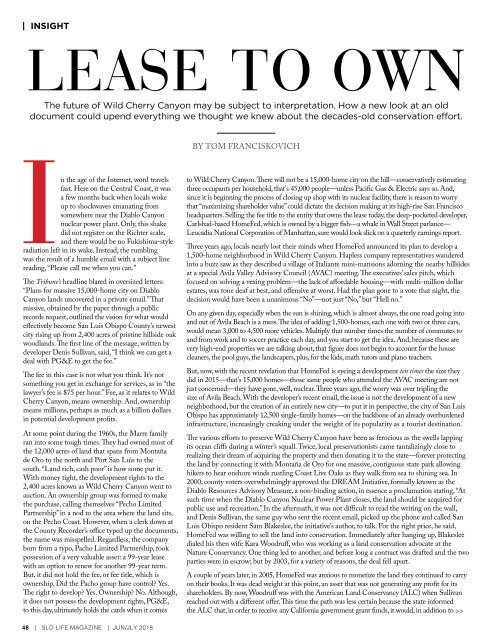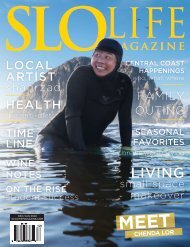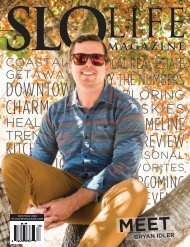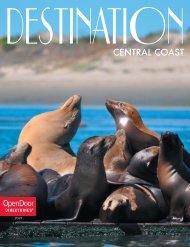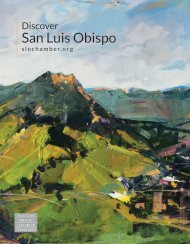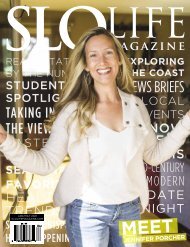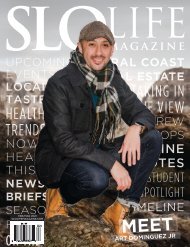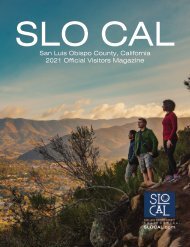SLO LIFE Jun/Jly 2018
You also want an ePaper? Increase the reach of your titles
YUMPU automatically turns print PDFs into web optimized ePapers that Google loves.
| INSIGHT<br />
LEASE TO OWN<br />
The future of Wild Cherry Canyon may be subject to interpretation. How a new look at an old<br />
document could upend everything we thought we knew about the decades-old conservation effort.<br />
BY TOM FRANCISKOVICH<br />
In the age of the Internet, word travels<br />
fast. Here on the Central Coast, it was<br />
a few months back when locals woke<br />
up to shockwaves emanating from<br />
somewhere near the Diablo Canyon<br />
nuclear power plant. Only, this shake<br />
did not register on the Richter scale,<br />
and there would be no Fukishima-style<br />
radiation left in its wake. Instead, the rumbling<br />
was the result of a humble email with a subject line<br />
reading, “Please call me when you can.”<br />
The Tribune’s headline blared in oversized letters:<br />
“Plans for massive 15,000-home city on Diablo<br />
Canyon lands uncovered in a private email.” That<br />
missive, obtained by the paper through a public<br />
records request, outlined the vision for what would<br />
effectively become San Luis Obispo County’s newest<br />
city rising up from 2,400 acres of pristine hillside oak<br />
woodlands. The first line of the message, written by<br />
developer Denis Sullivan, said, “I think we can get a<br />
deal with PG&E to get the fee.”<br />
The fee in this case is not what you think. It’s not<br />
something you get in exchange for services, as in “the<br />
lawyer’s fee is $75 per hour.” Fee, as it relates to Wild<br />
Cherry Canyon, means ownership. And, ownership<br />
means millions, perhaps as much as a billion dollars<br />
in potential development profits.<br />
At some point during the 1960s, the Marre family<br />
ran into some tough times. They had owned most of<br />
the 12,000 acres of land that spans from Montaña<br />
de Oro to the north and Port San Luis to the<br />
south. “Land rich, cash poor” is how some put it.<br />
With money tight, the development rights to the<br />
2,400 acres known as Wild Cherry Canyon went to<br />
auction. An ownership group was formed to make<br />
the purchase, calling themselves “Pecho Limited<br />
Partnership” in a nod to the area where the land sits,<br />
on the Pecho Coast. However, when a clerk down at<br />
the County Recorder’s office typed up the documents,<br />
the name was misspelled. Regardless, the company<br />
born from a typo, Pacho Limited Partnership, took<br />
possession of a very valuable asset: a 99-year lease<br />
with an option to renew for another 99-year term.<br />
But, it did not hold the fee, or fee title, which is<br />
ownership. Did the Pacho group have control? Yes.<br />
The right to develop? Yes. Ownership? No. Although,<br />
it does not possess the development rights, PG&E,<br />
to this day, ultimately holds the cards when it comes<br />
to Wild Cherry Canyon. There will not be a 15,000-home city on the hill—conservatively estimating<br />
three occupants per household, that's 45,000 people—unless Pacific Gas & Electric says so. And,<br />
since it is beginning the process of closing up shop with its nuclear facility, there is reason to worry<br />
that “maximizing shareholder value” could dictate the decision making at its high-rise San Francisco<br />
headquarters. Selling the fee title to the entity that owns the lease today, the deep-pocketed developer,<br />
Carlsbad-based HomeFed, which is owned by a bigger fish—a whale in Wall Street parlance—<br />
Leucadia National Corporation of Manhattan, sure would look slick on a quarterly earnings report.<br />
Three years ago, locals nearly lost their minds when HomeFed announced its plan to develop a<br />
1,500-home neighborhood in Wild Cherry Canyon. Hapless company representatives wandered<br />
into a buzz saw as they described a village of Italiante mini-mansions adorning the nearby hillsides<br />
at a special Avila Valley Advisory Council (AVAC) meeting. The executives’ sales pitch, which<br />
focused on solving a vexing problem—the lack of affordable housing—with multi-million dollar<br />
estates, was tone deaf at best, and offensive at worst. Had the plan gone to a vote that night, the<br />
decision would have been a unanimous “No”—not just “No,” but “Hell no.”<br />
On any given day, especially when the sun is shining, which is almost always, the one road going into<br />
and out of Avila Beach is a mess. The idea of adding 1,500-homes, each one with two or three cars,<br />
would mean 3,000 to 4,500 more vehicles. Multiply that number times the number of commutes to<br />
and from work and to soccer practice each day, and you start to get the idea. And, because these are<br />
very high-end properties we are talking about, that figure does not begin to account for the house<br />
cleaners, the pool guys, the landscapers, plus, for the kids, math tutors and piano teachers.<br />
But, now, with the recent revelation that HomeFed is eyeing a development ten times the size they<br />
did in 2015—that's 15,000 homes—those same people who attended the AVAC meeting are not<br />
just concerned—they have gone, well, nuclear. Three years ago, the worry was over tripling the<br />
size of Avila Beach. With the developer’s recent email, the issue is not the development of a new<br />
neighborhood, but the creation of an entirely new city—to put it in perspective, the city of San Luis<br />
Obispo has approximately 12,500 single-family homes—on the backbone of an already overburdened<br />
infrastructure, increasingly creaking under the weight of its popularity as a tourist destination.<br />
The various efforts to preserve Wild Cherry Canyon have been as ferocious as the swells lapping<br />
its ocean cliffs during a winter’s squall. Twice, local preservationists came tantalizingly close to<br />
realizing their dream of acquiring the property and then donating it to the state—forever protecting<br />
the land by connecting it with Montaña de Oro for one massive, contiguous state park allowing<br />
hikers to hear onshore winds rustling Coast Live Oaks as they walk from sea to shining sea. In<br />
2000, county voters overwhelmingly approved the DREAM Initiative, formally known as the<br />
Diablo Resources Advisory Measure, a non-binding action, in essence a proclamation stating, “At<br />
such time when the Diablo Canyon Nuclear Power Plant closes, the land should be acquired for<br />
public use and recreation.” In the aftermath, it was not difficult to read the writing on the wall,<br />
and Denis Sullivan, the same guy who sent the recent email, picked up the phone and called San<br />
Luis Obispo resident Sam Blakeslee, the initiative’s author, to talk. For the right price, he said,<br />
HomeFed was willing to sell the land into conservation. Immediately after hanging up, Blakeslee<br />
dialed his then wife Kara Woodruff, who was working as a land conservation advocate at the<br />
Nature Conservancy. One thing led to another, and before long a contract was drafted and the two<br />
parties were in escrow; but by 2003, for a variety of reasons, the deal fell apart.<br />
A couple of years later, in 2005, HomeFed was anxious to monetize the land they continued to carry<br />
on their books. It was dead weight at this point, an asset that was not generating any profit for its<br />
shareholders. By now, Woodruff was with the American Land Conservancy (ALC) when Sullivan<br />
reached out with a different offer. This time the path was less certain because the state informed<br />
the ALC that, in order to receive any California government grant funds, it would, in addition to >><br />
48 | <strong>SLO</strong> <strong>LIFE</strong> MAGAZINE | JUN/JLY <strong>2018</strong>


